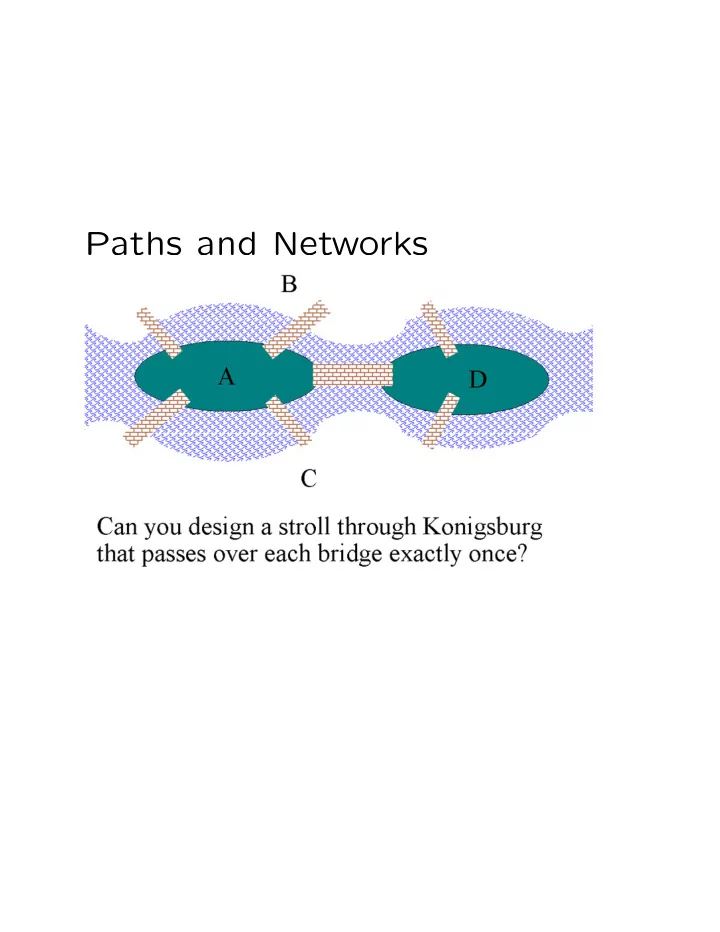

Paths and Networks
Definition 1 (Graph). A graph consists of points (called vertices) and lines or curves (called edges) connecting two points. Definition 2 (Loop). A loop is an edge start- ing and ending at the same vertex. Definition 3 (Odd Vertex). An odd vertex is a vertex with an odd number of attached edges. Definition 4 (Even Vertex). An even vertex is a vertex with an even number of attached edges. Definition 5 (Path). A path is a route along edges starting and ending at vertices. Definition 6 (Circuit). A circuit is a path that begins and ends at the same vertex. Definition 7 (Connected). A graph is con- nected if for each pair of vertices there is at least one path connecting them. Otherwise, the graph is said to be disconnected. Definition 8 (Eulerian Path). A path that includes each edge of a graph exactly once is called an Eulerian Path. An Eulerian Path that is also a circuit is called an Eulerian Circuit.
Theorem 1 (Euler’s Theorem). A graph has an Eulerian circuit if and only if it is connected and all of its vertices are even. A graph has an Eulerian path if and only if it is connected and has either no odd vertices or exactly two odd vertices, in which case the path must begin at one odd circuit and end at another. Definition 9 (Eulerization). The process of adding edges to a graph in order to guarantee the existence of an Eulerian Circuit is called Eulerization. We are only allowed to add edges to vertices that already have an edge connect- ing them.
Process for Eulerizing a Graph Pair each odd vertex with another odd vertex close to it. Find the path with the fewest edges connecting them and then duplicate the edges along that path. Applications • Four Color Theorem • Postal Route • Salesman’s Route • Newspaper Route
Traveling Salesman Problem Definition 10 (Hamiltonian Circuit). A Hamil- tonian Circuit is a circuit that goes through every vertex (except the starting and ending one) exactly once. There is no quick method for determining whether a Hamiltonian Circuit exists. Definition 11 (Weighted Graph). A graph for which each edge is assigned a number or weight is called a Weighted Graph. Definition 12 (Complete Graph). A graph is called complete if there is exactly one edge between every pair of vertices. Definition 13 (Traveling Salesman Prob- lem). The Traveling Salesman Problem is the problem of finding a Hamiltonian Circuit in a complete weighted graph for which the sum of the weights of the edges is a minimum. There is no known efficient algorithm that will solve the Traveling Salesman Problem.
Applications • Traveling Salesman • Meter Reader • Supervisor with multiple offices to super- vise • Delivery Route
Nearest Neighbor Algorithm Start at the vertex at which the circuit is sup- posed to begin and end. At each vertex, choose the next vertex to be the nearest one that has not yet been visited until it’s time to return to the starting vertex. Greedy Algorithm At each step, mark the unmarked edge of least weight which does not create a circuit not vis- iting every vertex and does not result in three marked edges coming out of the same vertex.
Minimal Spanning Trees Definition 14 (Tree). A tree is a graph which is connected but contains no circuits. Definition 15 (Spanning Tree). A spanning tree is a subgraph that is a tree containing all the vertices of the graph. Definition 16 (Minimum Spanning Tree). A minimum spanning tree for a weighted graph is a spanning tree for which the sum of the weights of the edges is a minimum.
Applications • Road network connecting cities and towns • Walkways • Irrigation system • Airline network • Computer network
Prim’s Algorithm for Finding a Minimum Spanning Tree Starting with any vertex, at each step find the nearest vertex to the current tree that is not already contained in the current tree and con- nect it with the shortest possible edge.
Recommend
More recommend